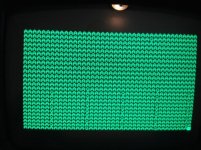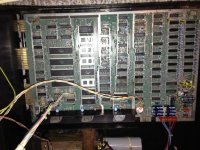Good morning!
I recently rescued a 2001-32n that had a family of mice living in it for quite a long time. After finally removing all of the carcasses and about a pillow's worth of bedding, I've pretty much got everything cleaned up and back together.
Following cleaning, I checked it over and plugged it in. It powers up just fine (wow) but I have a little problem. Let me describe the symptoms:
When it tries to start, it drops into the monitor with the PC at D379 and the SP at F6. At first I thought it might be a corrupted eprom, but every now and then it will actually halt at a different instruction.
Additionally, there is some kind of corruption going on somewhere. At the bottom of the screen there are 5 columns of zeroes spread out across the screen in a pattern as pictured below. You can sort of see another artifact that really looks like something's crossed somewhere.. There is a sort of "ghost" of these columns offset up and to the right. The ghost columns are scanning bottom to top, looking like some kind of clock line is crossed somewhere.
If I fill the screen with "A" you can see that various positions are corrupted to "Q". Where would you guys start?


I recently rescued a 2001-32n that had a family of mice living in it for quite a long time. After finally removing all of the carcasses and about a pillow's worth of bedding, I've pretty much got everything cleaned up and back together.
Following cleaning, I checked it over and plugged it in. It powers up just fine (wow) but I have a little problem. Let me describe the symptoms:
When it tries to start, it drops into the monitor with the PC at D379 and the SP at F6. At first I thought it might be a corrupted eprom, but every now and then it will actually halt at a different instruction.
Additionally, there is some kind of corruption going on somewhere. At the bottom of the screen there are 5 columns of zeroes spread out across the screen in a pattern as pictured below. You can sort of see another artifact that really looks like something's crossed somewhere.. There is a sort of "ghost" of these columns offset up and to the right. The ghost columns are scanning bottom to top, looking like some kind of clock line is crossed somewhere.
If I fill the screen with "A" you can see that various positions are corrupted to "Q". Where would you guys start?



